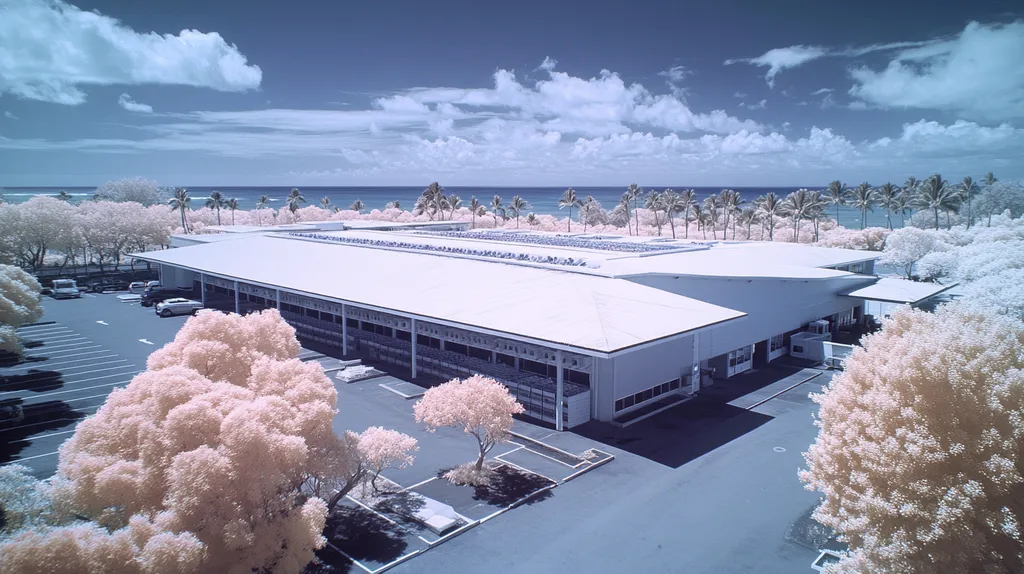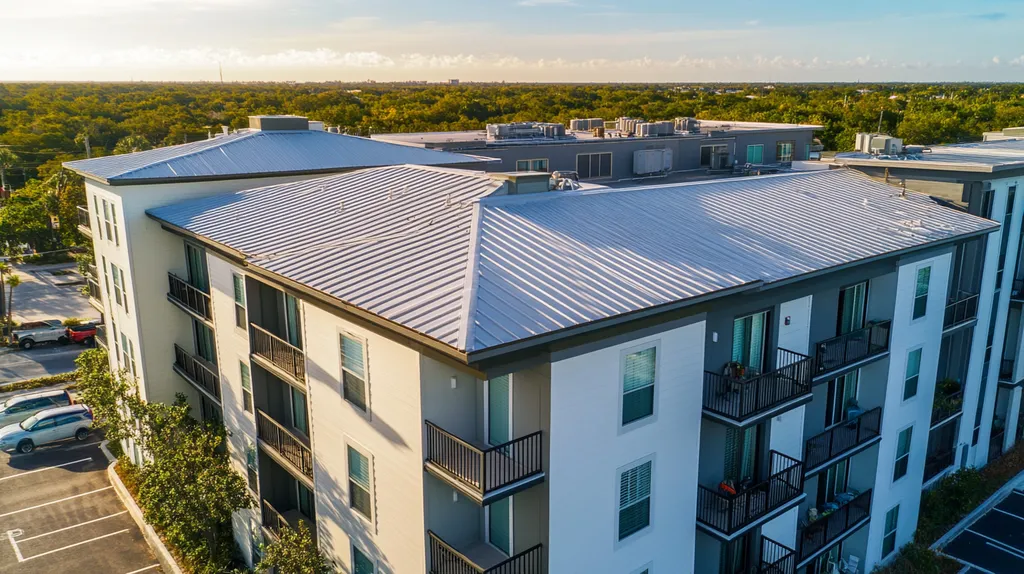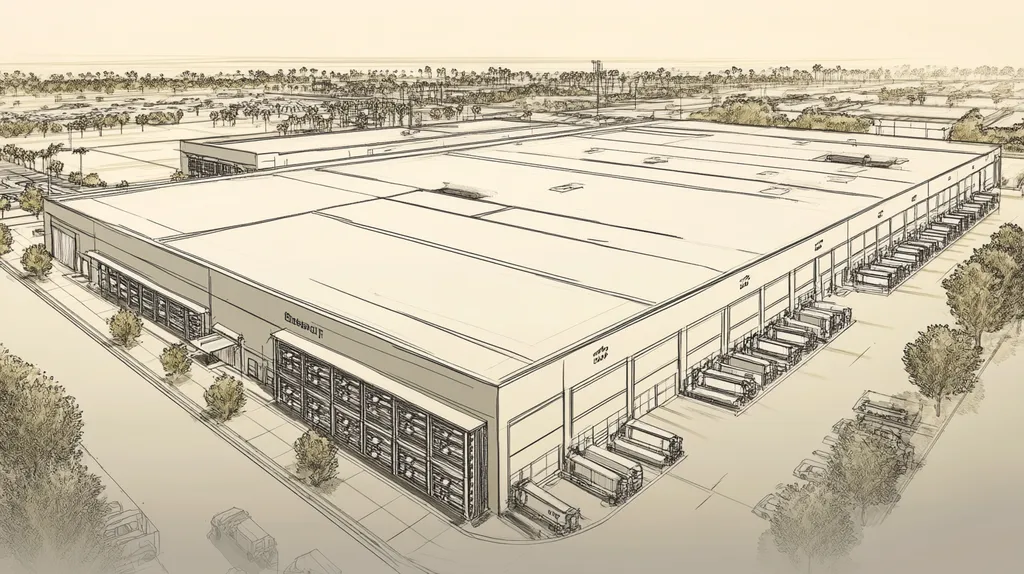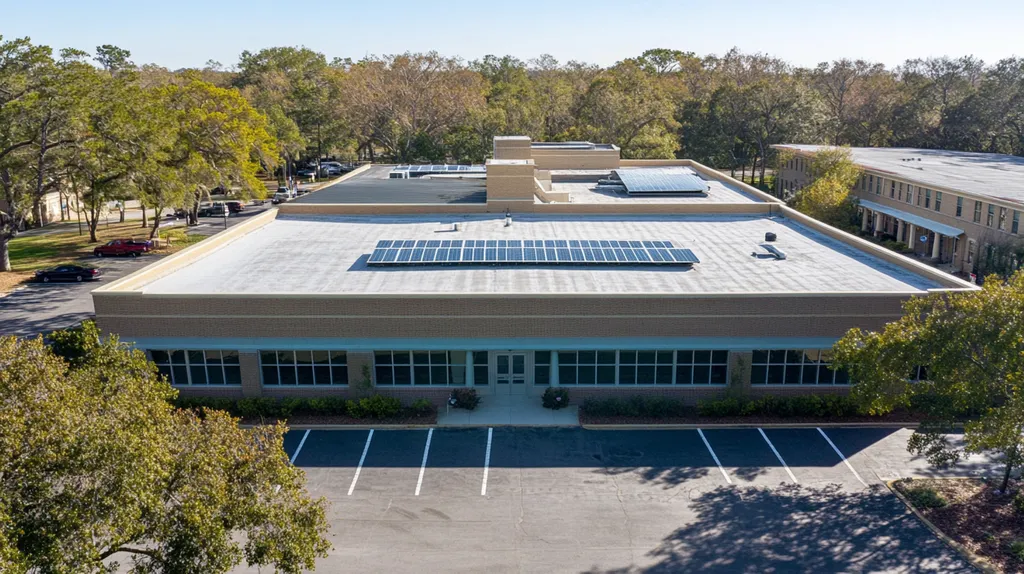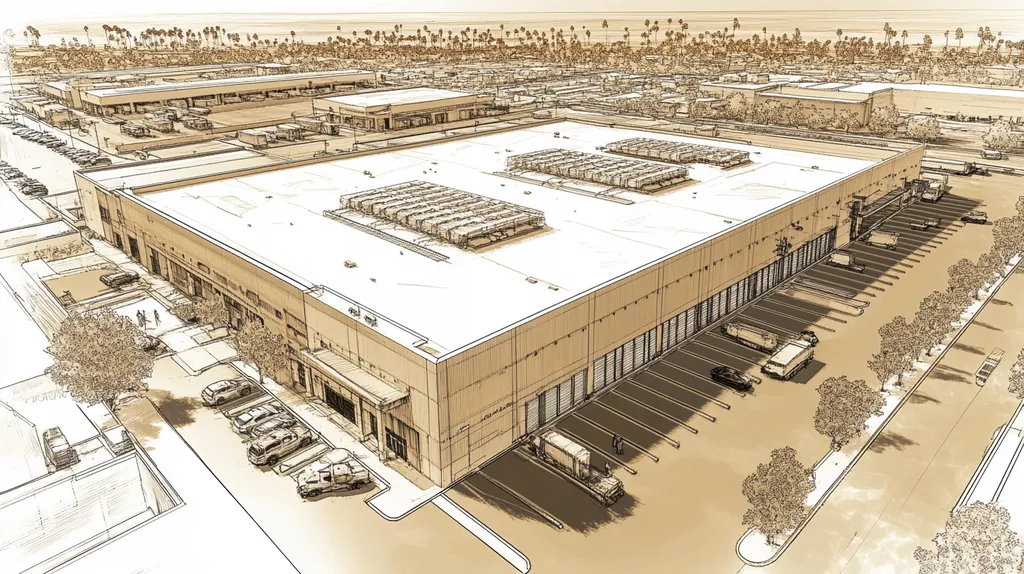Every passing day without proper roof inspection brings commercial buildings closer to costly failures. Industry studies show that 90% of roof problems stem from neglected maintenance, with the average leak repair costing $15,000 when caught late versus just $750 if identified early.
For today’s complex commercial roofing systems, protecting these vital assets requires understanding key inspection elements, from membrane assessment to drainage evaluation.
This comprehensive guide examines critical factors in commercial roof maintenance, breaking down essential knowledge that helps property managers prevent catastrophic failures while maximizing roof lifespan and performance.
SECTION 1: THE BASICS EXPLAINED
Time and weather take their toll on every commercial roof, yet many building owners only discover problems after water starts dripping onto their assets. Nearly 90% of premature roof failures stem from inadequate inspection and maintenance practices. Just as manufacturing equipment requires scheduled maintenance, your roof needs regular professional evaluation to prevent catastrophic failures that can shut down operations and damage inventory.
What It Is (In Plain Language)
A commercial roof inspection is like an annual physical for your building’s first line of defense. It involves a methodical evaluation of all roofing components, from membrane condition to drainage systems, identifying potential issues before they become emergencies.
Professional inspectors bring decades of experience in recognizing early warning signs that untrained eyes might miss. They assess everything from surface deterioration to flashing integrity, documenting findings with photographs and detailed notes.
The process includes checking seams, penetrations, and edge conditions where most leaks begin. Special attention goes to areas around HVAC units, pipes, and other rooftop equipment that can create vulnerable points in the roofing system.
Modern inspections also employ advanced technologies like infrared scanning to detect hidden moisture beneath the surface, allowing for precise problem identification without destructive testing.
Why It Matters (To Your Building)
Regular roof inspections protect more than just the roofing material – they safeguard your entire building investment. A small leak can quickly escalate into major structural damage, mold growth, and equipment failures that cost exponentially more than preventive maintenance.
Insurance companies increasingly require documented inspection programs. Without proper maintenance records, coverage may be denied for weather-related damage, leaving owners fully exposed to replacement costs.
Proper inspection programs typically extend roof life by 25-50% compared to reactive maintenance approaches. This translates to hundreds of thousands in saved capital expenses over a building’s lifetime.
Beyond direct costs, roof failures can interrupt business operations, damage inventory, and create liability issues. A comprehensive inspection program helps prevent these cascading consequences.
How It Works
Elements of a proper inspection include keeping roofs clean and free of debris while ensuring drainage systems remain clear and functional. These fundamental tasks prevent many common roofing problems before they start. (source: Travelers Insurance)
Inspections typically begin with a visual assessment from ground level, looking for obvious signs of distress. Inspectors then access the roof to examine details up close, paying special attention to areas where different materials meet.
Documentation includes detailed photographs and measurements of existing conditions. These records establish baseline conditions and track changes over time, helping predict when repairs or replacement might be needed.
After completing the inspection, professionals provide a comprehensive report outlining current conditions, needed repairs, and recommendations for ongoing maintenance. This becomes your roadmap for protecting your roofing investment.
SECTION 2: PRACTICAL APPLICATIONS
In the evolution of commercial roofing, we’ve witnessed a dramatic shift from simple tar-and-gravel systems to today’s sophisticated membrane technologies. Yet the fundamental need for systematic inspection remains unchanged. Today’s commercial roofs, housing millions in equipment and protecting vital operations, face unprecedented challenges from extreme weather patterns and rooftop equipment loads that would have been unimaginable decades ago.
Common Uses & Examples
Looking back at traditional built-up roofing systems, inspections focused primarily on surface deterioration and obvious leaks. Modern inspections have evolved into sophisticated evaluations that protect complex roofing assemblies worth hundreds of thousands of dollars.
Today’s comprehensive inspections deploy advanced technologies like infrared scanning and moisture mapping – tools that would have seemed like science fiction to earlier generations of roofers. These methods can detect problems weeks or months before they become visible.
Documentation has transformed from simple written reports to detailed digital records including high-resolution imagery, thermal scans, and precise measurements. This evolution enables tracking of minor changes that could signal developing issues.
Core inspection tasks still include traditional elements that have proven their worth over decades: examining seams, checking drainage patterns, and assessing flashings. These fundamental checks remain as crucial now as they were fifty years ago.
When You Need It Most
The history of catastrophic roof failures teaches us that timing is everything. Seasonal transitions – particularly from winter to spring and summer to fall – represent critical inspection periods that have remained constant through decades of roofing evolution.
Modern building codes and insurance requirements now mandate inspections after significant weather events – a practice that emerged from lessons learned in the aftermath of major storms throughout the 1970s and 1980s.
Any modification to rooftop equipment or penetrations demands immediate inspection – a protocol that developed as rooftops became increasingly crowded with mechanical systems and solar installations.
The traditional spring inspection remains vital, as winter’s freeze-thaw cycles can compromise even the most advanced roofing systems, much as they did with earlier roofing technologies.
Interactions With Other Systems
The relationship between roofing and building systems has grown increasingly complex since the days of simple exhaust vents and basic HVAC units. Modern roofs must accommodate sophisticated equipment while maintaining their protective integrity.
Drainage systems have evolved from simple scuppers to complex networks of internal drains and emergency overflow systems. These advanced configurations require more detailed inspection protocols than their predecessors.
The proliferation of rooftop equipment has transformed inspection requirements. Where once inspectors focused mainly on the roof itself, they now must evaluate numerous system interfaces and potential conflict points.
Building automation systems now monitor roof conditions in real-time, but these technologies complement rather than replace traditional hands-on inspection methods that have proven reliable for generations.
SECTION 3: KEY TERMINOLOGY DECODED
The evolution of commercial roofing terminology mirrors the industry’s technological advancement. What began as simple descriptions of tar and gravel systems has expanded into a complex technical vocabulary that can overwhelm even experienced property managers. Yet understanding this terminology remains critical – miscommunication about roofing terms leads to costly mistakes, with studies showing that terminology confusion contributes to nearly 30% of preventable roof failures.
Essential Terms Explained
The foundation of modern roofing vocabulary emerged from decades of field experience. Terms that were simple descriptions in the 1960s have evolved into precise technical definitions that shape today’s maintenance protocols.
“Membrane” has transformed from describing basic waterproof layers to encompassing sophisticated multi-ply systems with specific chemical and physical properties. Understanding membrane types and their characteristics directly impacts maintenance decisions.
The term “flashing” predates modern roofing but remains crucial, referring to materials that prevent water intrusion at roof transitions and penetrations. Proper flashing installation and maintenance prevent up to 80% of roof leaks.
“Assembly” now describes the complete roofing system, including insulation, cover boards, and attachments. This systems-based approach reflects how modern roofs function as integrated components rather than separate layers.
Industry Jargon Translated
Today’s roofing terminology includes specialized acronyms that emerged alongside technological advances. “EPDM” (Ethylene Propylene Diene Monomer) and “TPO” (Thermoplastic Polyolefin) represent modern single-ply options that replaced traditional built-up systems.
“R-value” evolved from basic insulation measurements to become a critical energy performance metric. Modern building codes now specify minimum R-values based on climate zones and building use.
“Positive drainage” describes slope configurations that prevent water pooling, a concept that gained prominence as flat roofs became standard in commercial construction. Understanding drainage terminology helps prevent moisture-related failures.
The term “roof assembly” encompasses not just the visible surface but all components working together as a system. This holistic approach reflects modern understanding of how roofs perform.
Measurement & Units Simplified
Traditional roofing measurements like “squares” (100 square feet) remain standard, but new metrics have emerged. Energy efficiency ratings and solar reflectance indices now influence material selection and maintenance planning.
Modern slope measurements use both ratio and degree specifications, allowing precise communication about drainage requirements. These measurements directly impact warranty coverage and maintenance protocols.
Load calculations have evolved beyond simple dead load figures to include complex considerations for equipment placement, snow accumulation, and wind uplift resistance. Understanding these measurements ensures proper structural support.
Environmental impact measurements now include categories unheard of in previous decades, such as solar reflectance index (SRI) and volatile organic compound (VOC) levels. These metrics help property owners meet sustainability goals while maintaining roof performance.
SECTION 4: DECISION FACTORS
When we look back at commercial roofing practices of the past decades, the evolution in decision-making approaches is striking. Where building owners once focused primarily on initial costs, today’s facility managers must navigate complex choices involving energy efficiency, sustainability, and long-term performance. Statistics show that improper decision-making in roof maintenance leads to a 40% reduction in roof lifespan, making these choices more critical than ever.
Cost Considerations
The financial landscape of commercial roofing has transformed dramatically since the days of simple tar and gravel systems. Modern facility managers must consider not just material and labor costs, but also energy efficiency impacts, maintenance requirements, and potential insurance premium effects.
Historical data shows that investing in quality materials and regular maintenance typically reduces total ownership costs by 30-40% over a roof’s lifetime. This stands in stark contrast to the “patch and pray” approach common in previous decades.
Building a commercial roof inspection plan should include cleaning debris and ensuring drainage systems remain clear and functional. These fundamental maintenance tasks prevent many expensive problems before they develop. (source: Travelers Insurance)
Modern budgeting approaches now factor in life-cycle costs rather than just initial expenses. This shift reflects hard lessons learned from past experiences where cheaper materials led to premature failures.
Performance Trade-offs
Today’s roofing decisions involve balancing factors that would have been unimaginable fifty years ago. Energy efficiency, solar reflectivity, and environmental impact now rank alongside traditional considerations of waterproofing and durability.
The emergence of cool roofing technologies has revolutionized how we evaluate performance trade-offs. Where dark surfaces were once standard, modern systems can reflect up to 80% of solar radiation.
Maintenance accessibility has become increasingly crucial as rooftops host more mechanical equipment. The days of vast, unobstructed roof surfaces have given way to complex landscapes requiring careful navigation.
Wind resistance requirements have evolved significantly, particularly in coastal regions. Modern systems must meet stringent uplift resistance standards that would have seemed excessive just decades ago.
Lifespan & Durability Factors
The evolution of roofing materials has dramatically extended potential lifespans, but only when properly maintained. Systems that once lasted 15-20 years can now endure for 30-40 years with appropriate care.
Climate change considerations have transformed durability requirements. Roofing systems must now withstand more extreme weather events than their predecessors ever faced.
Installation quality has become increasingly critical as systems grow more sophisticated. The margin for error has narrowed significantly compared to traditional built-up roofing methods.
Modern warranty programs reflect these changing expectations, often requiring documented maintenance programs. This represents a significant shift from the simple guarantees of previous generations.
SECTION 5: COMMON CHALLENGES
The evolution of commercial roofing challenges mirrors the increasing complexity of modern buildings. Where facility managers once dealt primarily with simple leaks, today’s roofs face unprecedented stresses from extreme weather events, heavy equipment loads, and complex building systems. Industry data shows that over 80% of commercial roof failures stem from overlooked early warning signs that could have been addressed through proper inspection and maintenance.
Frequent Problems & Solutions
The challenges facing commercial roofs have transformed significantly since the era of simple tar and gravel systems. Modern roofing assemblies must contend with increased foot traffic from maintenance crews servicing rooftop equipment, creating wear patterns unimaginable in previous decades.
Membrane seam failures, once a simple repair matter, now require sophisticated diagnostic approaches as materials have evolved. These critical junctions demand particular attention during inspections, as they remain the most vulnerable points in any roofing system.
Drainage problems persist as a leading cause of roof failures, though their nature has changed. Where simple scuppers once sufficed, today’s complex internal drainage systems require meticulous maintenance to prevent catastrophic backups.
Wind uplift resistance has become increasingly critical as extreme weather events intensify. Modern solutions incorporate advanced attachment methods and edge details that would have seemed excessive just a generation ago.
Warning Signs To Watch For
Roof inspection checklists must comprehensively evaluate both exterior and interior components, including roof edges, drainage systems, and signs of ponding water. Regular assessment of seams, fasteners, and penetrations helps prevent water infiltration before serious damage occurs.
Interior inspections now play a crucial role in detecting concealed problems that exterior checks might miss. Ceiling stains and wall discoloration often reveal hidden issues requiring immediate attention.
Advanced deterioration indicators have evolved beyond simple surface cracks. Modern systems may show subtle signs of stress through membrane displacement or changes in reflective coatings that weren’t relevant to previous generations of roofing. (source: American WeatherStar)
Equipment vibration effects represent a relatively new concern, as rooftops increasingly host heavy mechanical systems. These vibrations can compromise seam integrity and create stress patterns that demand regular monitoring.
Preventative Approaches
Modern preventative maintenance has evolved far beyond the simple patch-and-repair mentality of previous decades. Today’s approach integrates sophisticated monitoring systems with traditional hands-on inspection methods.
Documentation requirements have expanded significantly, reflecting both insurance demands and the need to track subtle changes over time. Digital recording systems now allow for precise comparison of conditions between inspections.
Seasonal maintenance protocols have become more complex as weather patterns grow less predictable. The traditional spring and fall inspection schedule now often requires supplemental checks after severe weather events.
Training requirements for maintenance personnel have increased dramatically as roofing systems become more sophisticated. What once required basic mechanical skills now demands understanding of complex material interactions and system interfaces.
SECTION 6: NEXT STEPS & RESOURCES
The evolution of commercial roofing has transformed what building owners need to know and do. While previous generations could rely on simple visual inspections, today’s complex roofing systems demand a more sophisticated approach. Studies indicate that properties implementing comprehensive inspection programs extend their roof lifespans by 50% compared to those using outdated assessment methods. Understanding current best practices, standards, and resources has become essential for protecting these valuable assets.
Questions To Ask Providers
The roofing industry has moved far beyond the days when a simple warranty and business license were sufficient qualifications. Modern providers should demonstrate expertise with current membrane technologies, diagnostic equipment, and preventive maintenance protocols.
Documentation capabilities have become crucial differentiators. Professional inspectors should offer detailed digital records, high-resolution imagery, and tracking systems that were unimaginable in previous decades.
Insurance and safety protocols deserve special attention, as requirements have evolved significantly. Ask about specific safety programs, insurance coverage levels, and emergency response capabilities.
Experience with your specific roofing system matters more than ever. The days of “one-size-fits-all” expertise have given way to specialized knowledge of particular membrane types and assembly methods.
Industry Standards & Guidelines
Building codes and standards have transformed dramatically since the era of simple built-up roofing systems. Today’s requirements encompass energy efficiency, wind resistance, and sustainability metrics that would have seemed excessive just decades ago.
Diagnostic standards have evolved to include non-destructive testing methods like infrared scanning and electronic leak detection. These technologies have revolutionized how we verify roof condition and identify developing problems.
Elements of a proper inspection program should include keeping roofs clean and free of debris while ensuring drainage systems remain clear and functional. These fundamental tasks prevent many common roofing problems before they start. (source: Travelers Insurance)
Warranty requirements now typically mandate specific maintenance protocols. This represents a significant shift from earlier generations of simple material guarantees.
Further Learning Simplified
Professional development in roofing has transformed from simple hands-on training to comprehensive educational programs. Modern facility managers need understanding of building science, energy performance, and system integration.
Industry associations offer specialized certifications that didn’t exist in previous decades. These programs combine traditional roofing knowledge with modern technical understanding.
Online resources have revolutionized access to roofing knowledge. Where technical information once spread slowly through the industry, digital platforms now provide immediate access to current best practices.
Networking opportunities have evolved beyond local contractor relationships. Regional and national organizations offer forums for sharing experiences and solutions across diverse climate zones and building types.
Looking Ahead
Commercial roof failures cost U.S. businesses over $5 billion annually, with 90% of these catastrophic events tracing back to inadequate inspection practices.
The evolution from simple tar-and-gravel systems to today’s sophisticated membrane assemblies demands a corresponding evolution in maintenance approaches.
As rooftop equipment proliferation and extreme weather events create unprecedented challenges, the stakes for proper inspection have never been higher.
The message from decades of industry experience remains clear: systematic inspection programs combining traditional hands-on evaluation with modern diagnostic technologies represent the most reliable path to maximizing roof lifespan and protecting valuable assets.
Those who embrace comprehensive inspection protocols consistently achieve 40-50% longer roof lifespans while dramatically reducing emergency repair costs.
FREQUENTLY ASKED QUESTIONS
Q. What is a commercial roof inspection?
A. A commercial roof inspection is a thorough evaluation of all roofing components. It identifies potential issues, ensuring the roof’s integrity and longevity before they escalate into bigger problems.
Q. How often should an industrial roof be inspected?
A. Industrial roofs should typically be inspected at least twice a year and after severe weather. This proactive approach helps detect and resolve minor issues before they cause significant damage.
Q. What key terms should I know about commercial roofs?
A. Understanding terms such as “membrane,” “flashing,” and “assembly” is crucial. These terms affect maintenance protocols and influence the long-term performance of the roofing system.
Q. What are the common challenges for commercial roofs?
A. Common challenges include drainage issues, membrane failures, and wind uplift. Addressing these problems early through inspections can prevent costly repairs and extend roof lifespan.
Q. How can I make effective decisions for my commercial roof?
A. Consider factors like material quality, energy efficiency, and maintenance costs. Balancing initial costs against long-term performance can help you make informed decisions for your roofing investments.
Q. What should I ask a commercial roof inspection provider?
A. Inquire about their experience, documentation capabilities, and insurance protocols. Understanding their inspection methods and safety standards ensures you choose a qualified provider for your roof’s needs.
Q. How can I prepare for a commercial roof inspection?
A. Ensure access to the roof is clear of debris and obstacles. Checking drainage systems before the inspection can also help identify any existing issues, making the process smoother and more effective.

